Back to: Sandy Red Sea Reef Slope 2 of
5, On to: Sandy Red Sea Reef Slope 4 of
5
Stony Corals, Order Scleractinia: play a minor role here.
There are occasional stands of acroporids, either branching Acropora or
more demure encrusting colonies of Montipora, but these are the
exception rather than dominant organisms. Occasionally one of a few
Goniopora species will dominate a bommie, coral rock area.
| Acropora hemprichii (Ehrenberg 1834), family
Acroporidae. Irregularly branched with radial corallites as open
thickets, large, round, upright, conical. Axial corallites common,
prostate, of thick smooth walls. Most are brown to pink in color,
some blue. Red Sea images. |
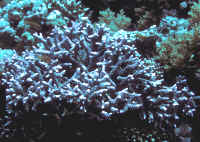
|
| Goniopora columna Dana 1846, family
Poritidae. Colonies as tufts on short columns. Corallites vary
depending on position. Ones toward the center of colonies have fine
columella and septa; those on the side more robust structures.
Polyps have large central cones. Indo-Western Pacific. Queensland
close-up and Red Sea images. |
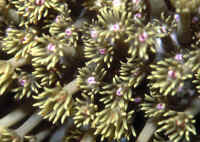 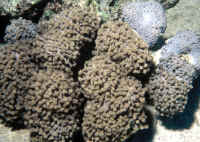
|
| Goniopora lobata Milne Edwards and Haime
1860. Colonies as columns with growth. Large (more than 5mm.)
corallites with small columellae and oral cones; elongate in
appearance on full extension. Tentacles and oral cones typically
white in color; contrasting with polyps which are otherwise brown,
tan or green. Below left in Queensland, Australia., and broken and
whole colonies in the Red Sea. |
| Favia laxa (Klunzinger 1879), family
Faviidae. Hemispherical colonies whose corallites are conical,
showing both extra- and intertentacular budding. Paliform lobes
look like an internal crown. Fine line of demarcation between
costae. Pale to pinkish brown in color. Common in the Red Sea where
this picture was made. |
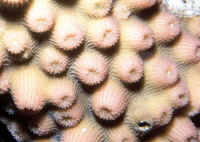
|
| Favia stelligera (Dana 1846), family
Faviidae. Colonies of round to columnar/colonial in appearance,
sometimes a few meters across. Uniform septa and walls (not
shared). Brown to green in color. Red Sea upper gulf photos. |
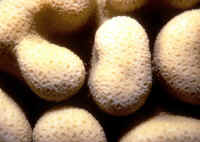 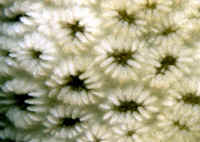
|
| Galaxea astreata Lamarck 1816. Generally
smaller corallites than G. fascicularis (3-5 versus 10
millimeter diameter), an important characteristic as these are the
two common species of this genus and their extensive ranges overlap
greatly. Tentacles usually only out at night. A close-up of a small
colony in Cebu, P.I. |
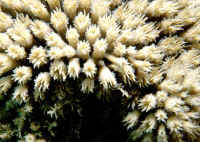
|
| Galaxea fascicularis Linnaeus 1767). Captive
colonies are ball-shaped, in the wild more like low-lying cushions
that may extend meters over the bottom. Corallites well-separated
with blade-like septa that may rise more than a cm. above the
corallite wall. Occur in grays, greens and browns. Transparent
tentacles out during the day, generally with contrasting colored
tips. Here in the Red Sea. |
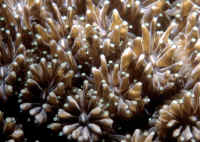 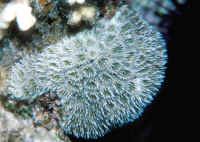
|
| Plerogyra sinuosa (Dana 1846), family
Euphylliidae (formerly Caryophylliidae). Flabello-meandroid
skeleton as shown, with grape-like variable vesicles that are slow
to retract (but still can/do sting). Typically found in turbid
water. Below: Skeleton close-up a small and large colony in
the Red Sea. |
Sea Anemones, Order Actinaria, occur throughout the Red Sea
at moderate depths. There are three principal species that are mutuals
of the single species of Clownfish found here (and occasionally a batch
of Dascyllus). Occasionally you may find a "Pizza Anemone".
If so, do look closely for its commensals.
| Heteractis
magnifica (Quoy & Gaimard 1833), the Magnificent Sea
Anemone. Found in open areas, attached to a solid object. Base of
solid purple, blue, green, red, white or brown color. Oral disc
flat with barely tapering, finger-like tentacles up to a meter
across. Specimen at Anemone City, Ras Mohamed at right
engulfed in a wash of Dascyllus trimaculatus. |
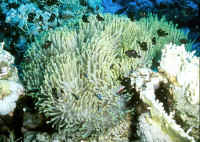
|
| Heteractis
crispa (Ehrenberg 1834), the Leathery Sea Anemone. Often
mis-sold/identified in the trade as H. ritteri and the
commonest species in the market as the "Sebae Anenome".
Has numerous long, tapering tentacles that end in points. Column
gray in color. A specimen in the Red Sea. |
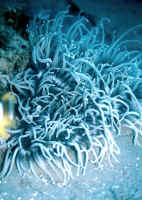
|
| Entacmaea
quadricolor (Ruppell & Leuckart 1828), the Bubble-Tip
or Bulb-Tentacle Sea Anemone. This is historically the
hardiest of large, naturally symbiotic Clownfish anemones for
aquarium use... many more specimens are collected and received in
tact, in reasonably good health from the wild to
distributors. A colonial grouping and a close-up image of the
Bubble-Tip Anemone and the Clownfish, Amphiprion bicinctus
in the Red Sea. |
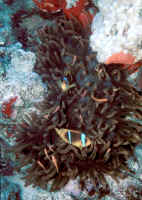 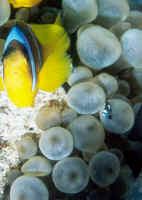
|
| Cryptodendrum adhaesivum
Klunzinger 1877, the Adhesive Sea Anemone, aka as the Pizza Anemone
for obvious reasons. Not often seen, used in the aquarium interest
due to the species extremely sticky short tentacles and propensity
for tearing in moving. Only one Clownfish species is found in it in
the wild, the Clarkii. Red Sea image and commensal "Sexy
Shrimp", Thor amboinensis |
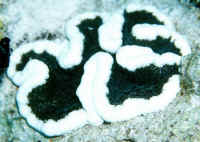 /Thor/Thor_amboinensisRSPr2.jpg)
|
Worms of Many Kinds, but particularly the Polychaete Annelids
mainly knowns as "bristleworms" to aquarium hobbyists exist
in good numbers of individuals and species in the Red Sea. Other worm
groups, worm-like animals exist here in abundance; Peanut Worms (phylum
Sipuncula), Tongue Worms (phylum Echiura), Ribbon Worms (phylum
Nemertea), Acorn Worms (phylum Hemichordata), but these are rarely
encountered by aquarists, or divers, unless they're digging about,
searching for them.
Molluscs: We've mentioned the Giant Clams, family
Tridacnidae above. There are some notable, common bivalves as well:
| Limaria fragilis Gmelin 1791, the Fragile
File Shell. Indo-Pacific; Red Sea to Japan, Australia. Takes a
beating if stocked with many types of fishes, crustaceans. Needs to
be inserted in rock cover. Need frequent "immersion type"
feedings... daily. Queensland, Australian photo. |
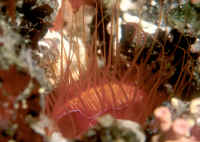
|
Crustaceans exist in all marine environments in the Red Sea,
and the Sandy Slope and beneath it are no exceptions. There are twenty
plus species of Stomatopods (Mantis Shrimp) for instance; though the
few species utilized in ornamental aquatics rarely are collected here.
The principal species utilized are the commensal and mutual shrimp
species largely gathered elsewhere. There are many true Crabs here, but
most hobbyists resist housing these opportunistic omnivores for fear
they'll eat there other livestock.
| Periclimenes longicarpus Red Sea, Arabian
Sea endemic. Usually associated with the Bubble Tip Anemone,
Entacmaea quadricolor, here on a Bubble Coral, Plerogyra
sinousa. There are at least 45 species of commensal shrimps of
the subfamily Pontiinae in the Red Sea. |
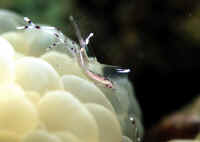
|
| Thor amboinensis (de Man 1888), the Squat
Anemone or Sexy Shrimp (in reference to its usually-raised tail).
1/4-3/4" long. Common in all tropical seas. Found in
association with Giant, Sun, Elegant Anemones. Here is a pair
(female larger) in a Pizza Anemone, Cryptodendrum
adhaesivum. |
/Thor/Thor_amboinensisRSPr.jpg)
|
| Snapping Shrimps, family Alpheidae. Noted
for their noise making capacity, myths re the power of their large
claw (a .22 caliber, tank-cracking...) and commensal to mutualistic
relationships with fishes (mainly Gobies) and invertebrates. At
least ninety five species are recorded from the Red Sea. |
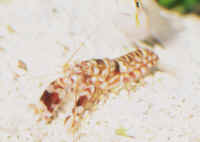
|
Hermit Crabs, infraorder Anomura. There are about four dozen
species of Hermits in seven families described from the Red Sea. Most
are of dubious value (to destructive) in marine, especially reef
aquariums. I'll list a few of the more commonly encountered in the
trade that can be found here.
| Trizopagurus strigatus
(Herbst 1804), the Striped or Halloween Hermit Crab. Indo-Pacific
and Red Sea. To a little over two inches in length. Nocturnal.
Lives in empty Cone shells. Feed on live and dead animal
material. |
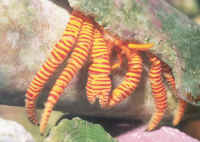
|
| Dardanus tinctor, a Coral
Hermit Crab. This one with its Calliactis polypus
Anemones out at night in the Red Sea. To 10 cm. Large left claw.
Nocturnal; omnivorous. Moves anemones when transferring to new
shells. |
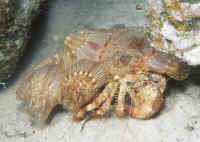
|
| Dardanus lagopodes
(Forsskal 1775), the Blade-eyed Hermit Crab. Indo-Pacific,
including the Red Sea. To a little over two inches in length. White
eye stalks, body mottled in maroon, brown, covered with
white-tipped bristles. This one in Aitutaki, Cook
Islands. |
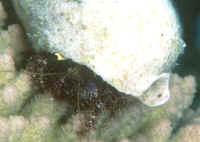
|
Spiny Skinned Animals, phylum Echinodermata. The Red Sea
Sandy Slope has a number of echinoderms, but most are either too touchy
or too large for aquarium use. One Sea Cucumber that is found here does
make it into the trade.
|
Holothuria edulis Lesson 1830, the Edible
Sea Cucumber (no thanks, I'm full). Indo-Pacific; Red Sea to
Hawai'i. Lives in the open, on sand, seagrass beds, under
rocks. Substrate licker. To one foot in length. Aquarium and
Fiji images.
|
 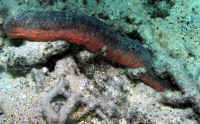
|
Back to: Sandy Red Sea Reef Slope 2 of
5, On to: Sandy Red Sea Reef Slope 4 of
5
|
|

